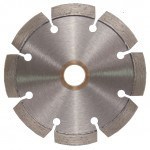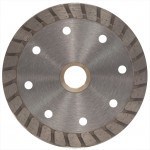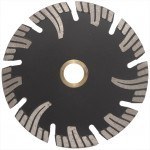Free Shipping Over $149 Across Canada*
 Diamond blades are made of a high quality steel core with a matrix around the perimeter composed of synthetic diamonds embedded in a bonding material.
Diamond blades are made of a high quality steel core with a matrix around the perimeter composed of synthetic diamonds embedded in a bonding material.
Some diamond blades are designed to run dry in applications
Two broad factors are used to evaluate what particular diamond blades should be used to cut and how long they will last: Type of bond and Style of blade.
Type of Bond:
The type of bond used to hold the diamonds diamonds varies between different levels of softness and hardness. In addition to giving a base for the diamonds, the bond allows for a specific wear rate to match the material being cut.
Usually bond hardness is the inverse of the hardness of the material. For hard materials such as procelain, the bond should be soft so that it wears down porportionally in order to expose new diamonds and deliver a clean cut.
Ideally all diamond blades would use a soft bond so that new diamonds would be continuously exposed to ensure a clean cut. However, a soft bond also reduces the life of a blade. Consequently, most manufacturers use a hard bond for blades designed for cutting softer materials.
Since most manufacturers do not specify the bonding method, it is important to check the packaging to see what type of cutting is recommended for a particular blade.
As a rule of thumb, if the blade is sparking or bouncing when cutting hard material, a blade with a softer bond is needed. Cutting hard material with a hard bond will glaze the blade and require dressing the blade with a dressing stick or running the blade through soft material such as asphalt to expose more diamonds.
Blade Styles:
1. Segmented Rim - Rough, Fast Cutting
- Segmented rim diamond blades have segments with a continuous matrix.
- They can be run either dry or wet. Running these blades wet will prolong their service life.
- Segmented blades are the best option for cutting when water is not available.
- The cut-outs (segments) on the edge of the blade allow for air flow and cooling of the blade core.
- The segments also provide better exhaust of debris to deliver a faster cut.
- Segmented rim blades provide the roughest cut.
- Typical applications include cutting concrete, brick, concrete pavers, masonry/block, hard/reinforced concrete and limestone.
2. Turbo Rim - Clean, Accurate, Smooth Cutting
- Turbo rim blades are designed to cut faster in wet or dry applications.
- Smaller segments on the rim deliver blade cooling with an integrated interweaving diamond matrix.
- Turbo rim blades often have small holes scattered throughout the blade to increase the cooling capacity of the blades.
- The design of the turbo segments helps push the material out and allows faster cutting.
- Turbo rim blades effectively cut concrete, brick and limestone.
3. Segmented-Turbo Rim - Balances Speed and Smooth Cutting
- Segmented-Turbo rim blades have segments with turbo matrix.
- Turbo matrix provides smooth cutting.
- Segments provide less surface contact to increase speed of cut.
4. Continuous Rim - Cleanest, Most Precise Cutting
- Continuous rim blades are commonly referred to as wet cut blades.
- Water cools the blade for longer life, flushes out debris for less friction in the cutting zone and reduces dust buildup which would decrease tool life.
- Continuous rim diamond blades deliver better, but slower cuts than the other styles of diamond blades.
- Typical applications are for cutting marble, granite, porcelain tile and ceramic tile.
Click here for BC Fasteners & Tools Diamond Blade Selection





